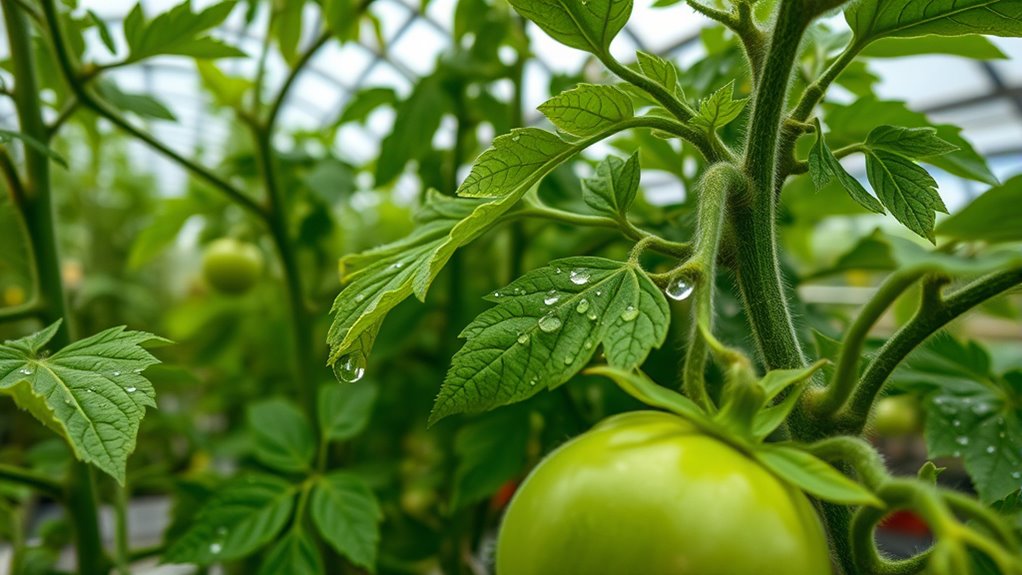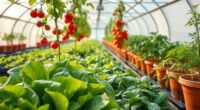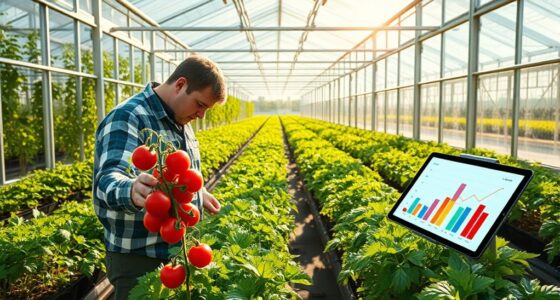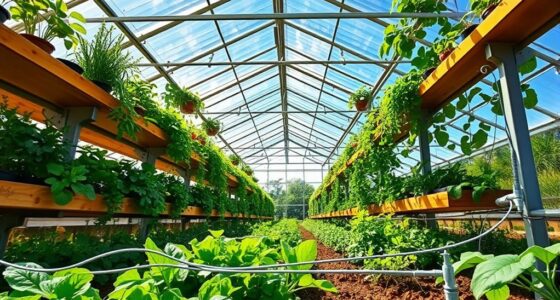To prevent and manage diseases naturally in your greenhouse, focus on maintaining ideal environmental conditions by controlling humidity and ensuring good air circulation. Incorporate biological controls like beneficial insects, predatory mites, and microbial products to fight pests and pathogens effectively. Regular sanitation, crop rotation, and early detection are key to stopping disease spread. Using these sustainable strategies helps keep plants healthy; exploring further will reveal even more effective techniques to protect your crops.
Key Takeaways
- Implement integrated pest management with beneficial insects and microbial products to naturally control pests and diseases.
- Maintain optimal environmental conditions, such as proper ventilation and humidity control, to prevent disease development.
- Conduct regular inspections to detect early signs of disease and enable timely, targeted interventions.
- Sanitize tools and rotate crops to reduce pathogen spread and soil-borne disease buildup.
- Foster a healthy greenhouse ecosystem by combining biological controls with good cultural and sanitation practices.
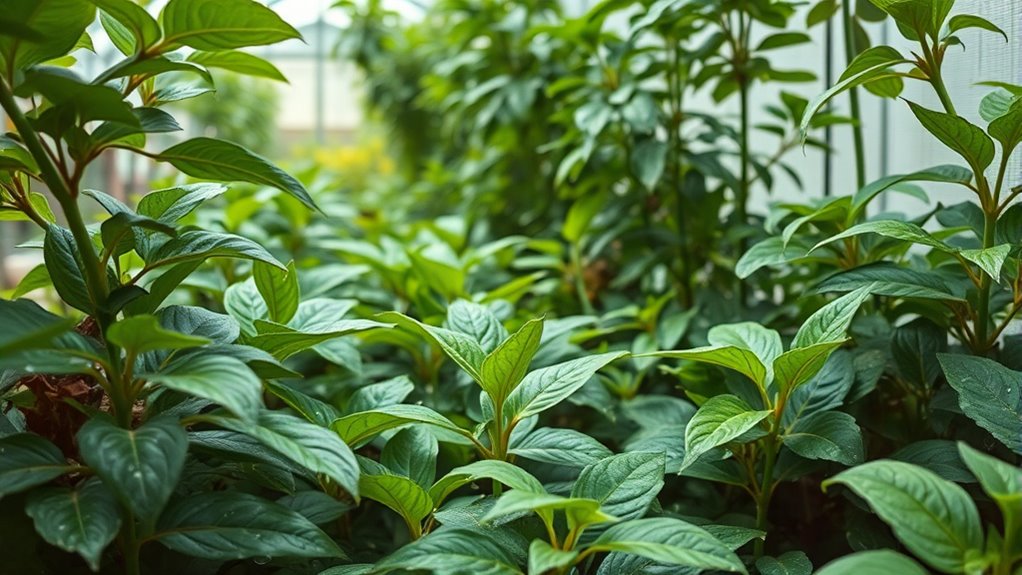
Maintaining plant health in greenhouses is essential for ensuring healthy growth and maximizing yields. One of the most effective ways to do this is by implementing natural methods to prevent and manage diseases. Biological controls play a crucial role in this approach, offering a sustainable alternative to chemical pesticides. These biological agents, such as beneficial insects, predatory mites, or microbial products, help keep pest populations in check without harming your plants or the environment. When used correctly, they can establish a balanced ecosystem within your greenhouse, reducing the likelihood of disease outbreaks caused by pests or pathogens.
Implementing biological controls naturally prevents diseases and promotes a healthy, balanced greenhouse ecosystem.
However, to successfully utilize biological controls, you need to be proactive in disease identification. Recognizing the early signs of plant diseases allows you to intervene before they spread extensively. Regular inspections are your best tool here. Look for symptoms like discolored or wilted leaves, unusual spots, mold, or lesions on stems and fruits. Early detection enables you to take targeted actions, such as applying specific biological controls or adjusting environmental conditions to suppress disease development. Familiarize yourself with common greenhouse diseases and their symptoms, so you can act swiftly and accurately. Incorporating disease management strategies from reputable sources can further enhance your efforts.
Disease identification isn’t just about spotting symptoms; it also involves understanding the environmental factors that promote disease development. Overly humid conditions, poor air circulation, or excess moisture on plant surfaces create ideal environments for fungi and bacteria to thrive. By maintaining proper ventilation, managing humidity levels, and avoiding overwatering, you reduce the chances of diseases taking hold. Combining these preventative measures with timely disease identification creates a strong defense system for your plants. Additionally, understanding how sustainable practices can contribute to healthier greenhouse environments can lead to more resilient crops. Recent studies also suggest that incorporating plant health strategies can further improve disease resistance and overall plant vigor.
Incorporating biological controls into your disease management plan isn’t complicated, but it requires consistency and attention. When you spot early signs of disease, you can introduce beneficial organisms that outcompete or prey on harmful pathogens, effectively curbing the problem. For example, releasing predatory insects to control pest populations reduces the risk of pest-borne diseases. Microbial products, like beneficial bacteria or fungi, can be applied to suppress soil-borne pathogens or leaf-inhabiting fungi. The key is to integrate these controls with good cultural practices, such as sanitizing tools, rotating crops, and maintaining ideal environmental conditions, to build a comprehensive defense against diseases. Additionally, understanding the importance of Pest Management can further enhance your overall plant health strategy.
Frequently Asked Questions
How Do I Identify Early Signs of Plant Diseases?
You want to spot early signs of plant diseases, so pay close attention to plant disease symptoms. Look for unusual spots, discoloration, wilting, or fuzzy growth on leaves and stems. Early detection signs include leaf yellowing, mold, or spots that spread quickly. By regularly inspecting your plants and noticing these subtle changes, you can catch problems early and take natural measures to prevent disease spread.
What Natural Remedies Are Most Effective Against Fungal Infections?
Imagine a gentle rain washing over your plants, fighting off pesky fungi naturally. Beneficial microbes, like Bacillus subtilis, outcompete harmful fungi, stopping infections before they start. Organic fungicides such as neem oil and copper-based solutions are also effective, creating a protective barrier. Together, these natural remedies strengthen your plants’ defenses without chemicals, ensuring healthy growth and vibrant greenery. Trust nature’s power to keep fungal infections at bay.
How Can I Improve Airflow to Prevent Disease Spread?
To improve airflow and prevent disease spread, focus on ventilation techniques like opening vents, using exhaust fans, and ensuring proper spacing between plants. Optimize airflow by regularly adjusting fans and vents to promote consistent circulation throughout your greenhouse. This helps reduce humidity and damp spots where fungi thrive. By maintaining proper airflow, you create a healthier environment that minimizes disease risks and supports robust plant growth.
Are There Specific Plants More Resistant to Diseases?
Some plants naturally have higher plant resistance, making them less disease prone. You should choose these resistant varieties to reduce your risk of disease. For example, certain herbs and vegetables are known for their disease resistance. By selecting disease-resistant plants, you can minimize the need for chemical treatments and promote healthier growth. Always research specific plant resistance traits before planting to guarantee you’re growing the most resilient options for your greenhouse.
How Often Should I Inspect My Greenhouse for Pests?
You should inspect your greenhouse regularly for pests, ideally on a weekly basis. Establish consistent inspection schedules to catch issues early through pest monitoring. Keep a close eye on vulnerable areas like leaf undersides, stems, and soil. Regular inspections help you identify pest problems promptly, allowing you to take natural control measures before infestations become severe. This proactive approach keeps your plants healthy and reduces the need for chemical treatments.
Conclusion
Maintaining plant health in your greenhouse is vital for thriving crops. By preventing and managing diseases naturally, you create a healthier environment for your plants and the planet. Did you know that up to 80% of plant diseases can be controlled through simple, natural methods? Embracing these techniques not only boosts your yields but also reduces chemical use. Stay proactive, stay informed, and watch your greenhouse flourish with vibrant, healthy plants.
